Roles and Responsibilities of Teachers: Indigenous Education Task 2
VerifiedAdded on 2020/03/16
|7
|1613
|130
Report
AI Summary
This report, titled "Roles and Responsibilities," examines the crucial roles and responsibilities of teachers in Indigenous education. It emphasizes that teaching extends beyond imparting knowledge, encompassing student assessment and understanding individual learning needs. The report delves into the significance of initial and diagnostic assessment methods for identifying student learning styles and requirements, highlighting their differences and applications. It underscores the importance of recognizing diverse backgrounds and cultural contexts in tailoring teaching approaches. The report discusses how identifying individual needs fosters student interest, organizes classrooms effectively, enhances quality, develops talents, and facilitates lesson planning. Ultimately, the report concludes that a combination of initial and diagnostic assessments empowers teachers to plan and modify their teaching strategies, leading to more effective and personalized learning experiences for students.
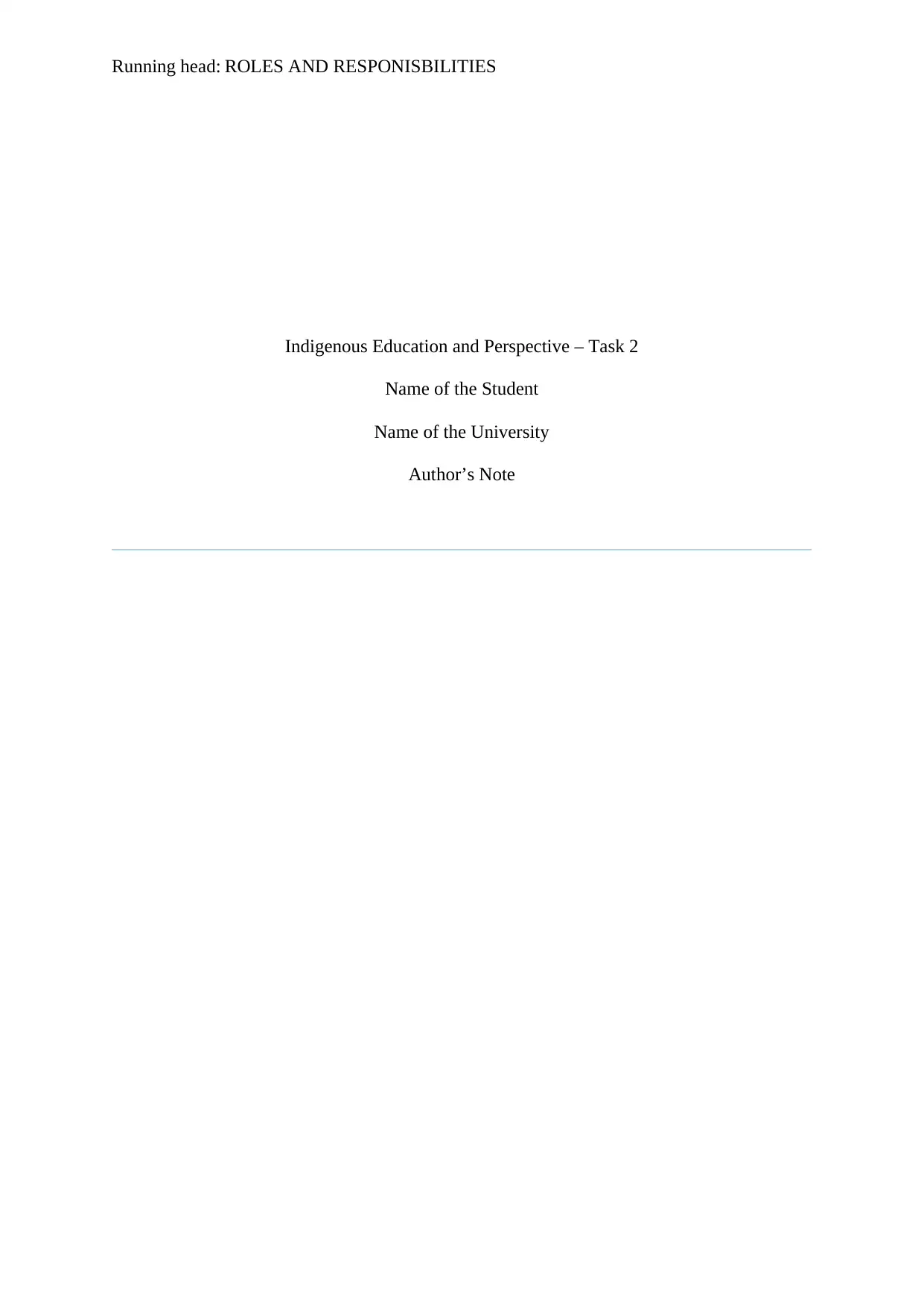
Running head: ROLES AND RESPONISBILITIES
Indigenous Education and Perspective – Task 2
Name of the Student
Name of the University
Author’s Note
Indigenous Education and Perspective – Task 2
Name of the Student
Name of the University
Author’s Note
Paraphrase This Document
Need a fresh take? Get an instant paraphrase of this document with our AI Paraphraser
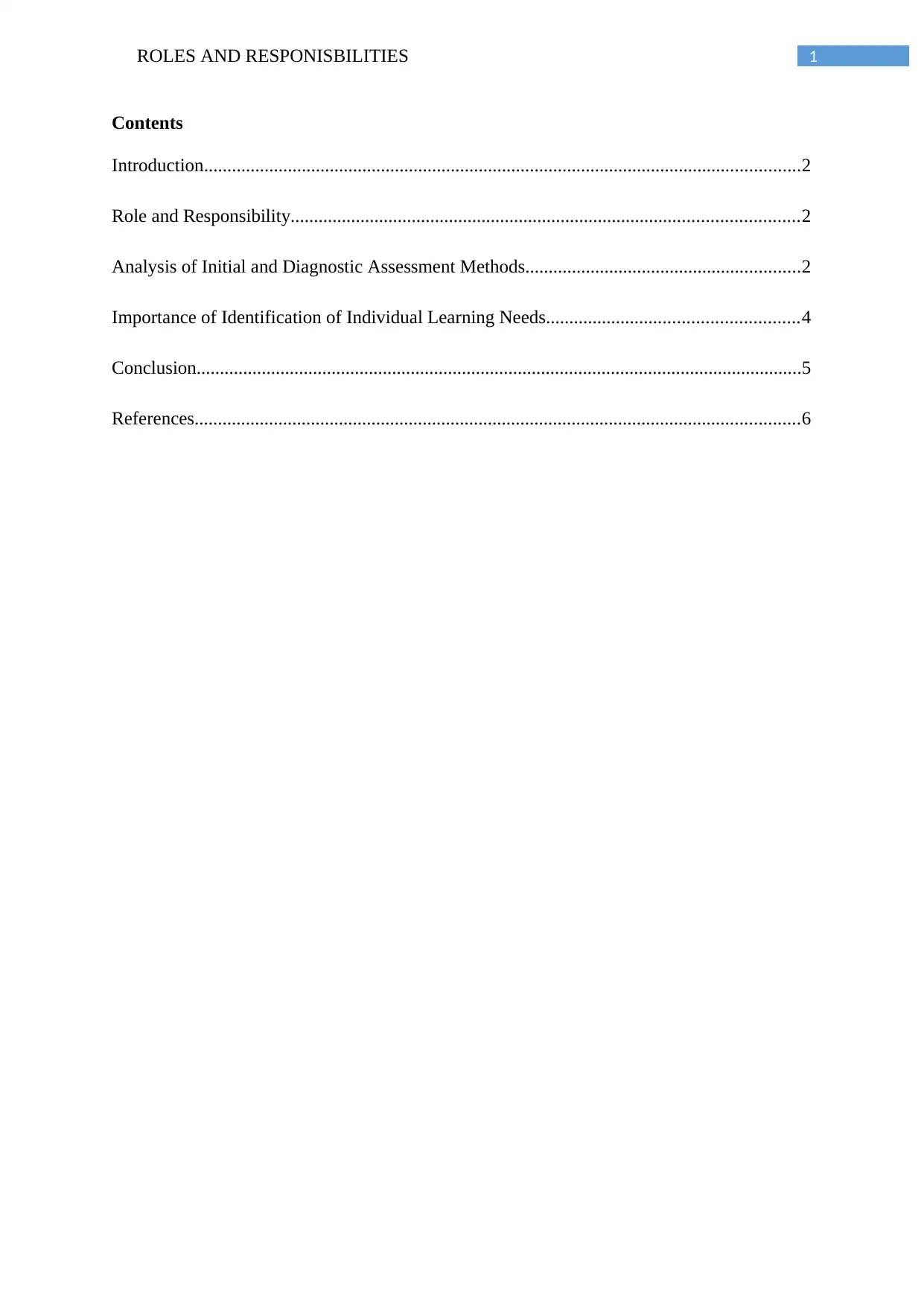
1ROLES AND RESPONISBILITIES
Contents
Introduction................................................................................................................................2
Role and Responsibility.............................................................................................................2
Analysis of Initial and Diagnostic Assessment Methods...........................................................2
Importance of Identification of Individual Learning Needs......................................................4
Conclusion..................................................................................................................................5
References..................................................................................................................................6
Contents
Introduction................................................................................................................................2
Role and Responsibility.............................................................................................................2
Analysis of Initial and Diagnostic Assessment Methods...........................................................2
Importance of Identification of Individual Learning Needs......................................................4
Conclusion..................................................................................................................................5
References..................................................................................................................................6
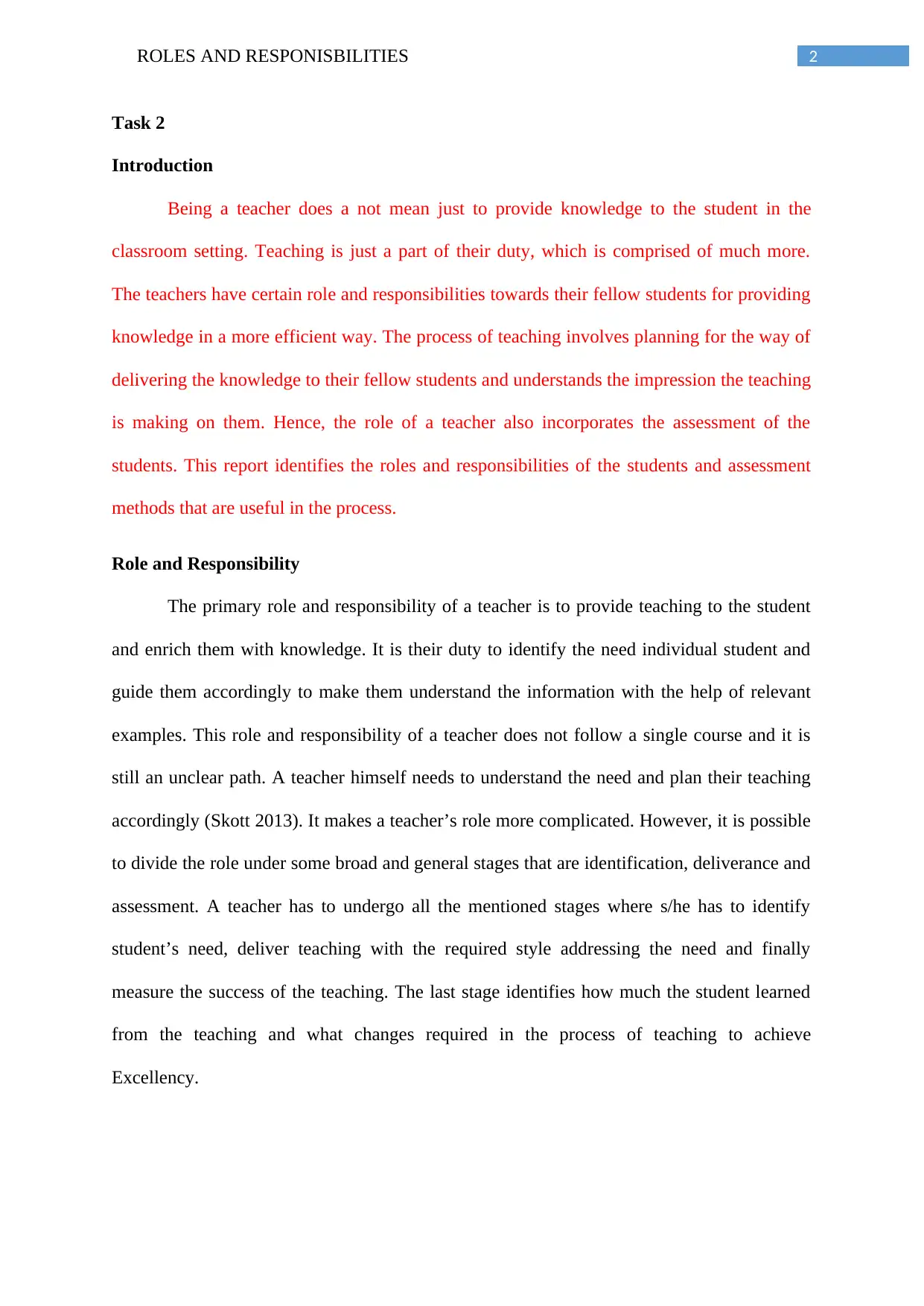
2ROLES AND RESPONISBILITIES
Task 2
Introduction
Being a teacher does a not mean just to provide knowledge to the student in the
classroom setting. Teaching is just a part of their duty, which is comprised of much more.
The teachers have certain role and responsibilities towards their fellow students for providing
knowledge in a more efficient way. The process of teaching involves planning for the way of
delivering the knowledge to their fellow students and understands the impression the teaching
is making on them. Hence, the role of a teacher also incorporates the assessment of the
students. This report identifies the roles and responsibilities of the students and assessment
methods that are useful in the process.
Role and Responsibility
The primary role and responsibility of a teacher is to provide teaching to the student
and enrich them with knowledge. It is their duty to identify the need individual student and
guide them accordingly to make them understand the information with the help of relevant
examples. This role and responsibility of a teacher does not follow a single course and it is
still an unclear path. A teacher himself needs to understand the need and plan their teaching
accordingly (Skott 2013). It makes a teacher’s role more complicated. However, it is possible
to divide the role under some broad and general stages that are identification, deliverance and
assessment. A teacher has to undergo all the mentioned stages where s/he has to identify
student’s need, deliver teaching with the required style addressing the need and finally
measure the success of the teaching. The last stage identifies how much the student learned
from the teaching and what changes required in the process of teaching to achieve
Excellency.
Task 2
Introduction
Being a teacher does a not mean just to provide knowledge to the student in the
classroom setting. Teaching is just a part of their duty, which is comprised of much more.
The teachers have certain role and responsibilities towards their fellow students for providing
knowledge in a more efficient way. The process of teaching involves planning for the way of
delivering the knowledge to their fellow students and understands the impression the teaching
is making on them. Hence, the role of a teacher also incorporates the assessment of the
students. This report identifies the roles and responsibilities of the students and assessment
methods that are useful in the process.
Role and Responsibility
The primary role and responsibility of a teacher is to provide teaching to the student
and enrich them with knowledge. It is their duty to identify the need individual student and
guide them accordingly to make them understand the information with the help of relevant
examples. This role and responsibility of a teacher does not follow a single course and it is
still an unclear path. A teacher himself needs to understand the need and plan their teaching
accordingly (Skott 2013). It makes a teacher’s role more complicated. However, it is possible
to divide the role under some broad and general stages that are identification, deliverance and
assessment. A teacher has to undergo all the mentioned stages where s/he has to identify
student’s need, deliver teaching with the required style addressing the need and finally
measure the success of the teaching. The last stage identifies how much the student learned
from the teaching and what changes required in the process of teaching to achieve
Excellency.
⊘ This is a preview!⊘
Do you want full access?
Subscribe today to unlock all pages.

Trusted by 1+ million students worldwide
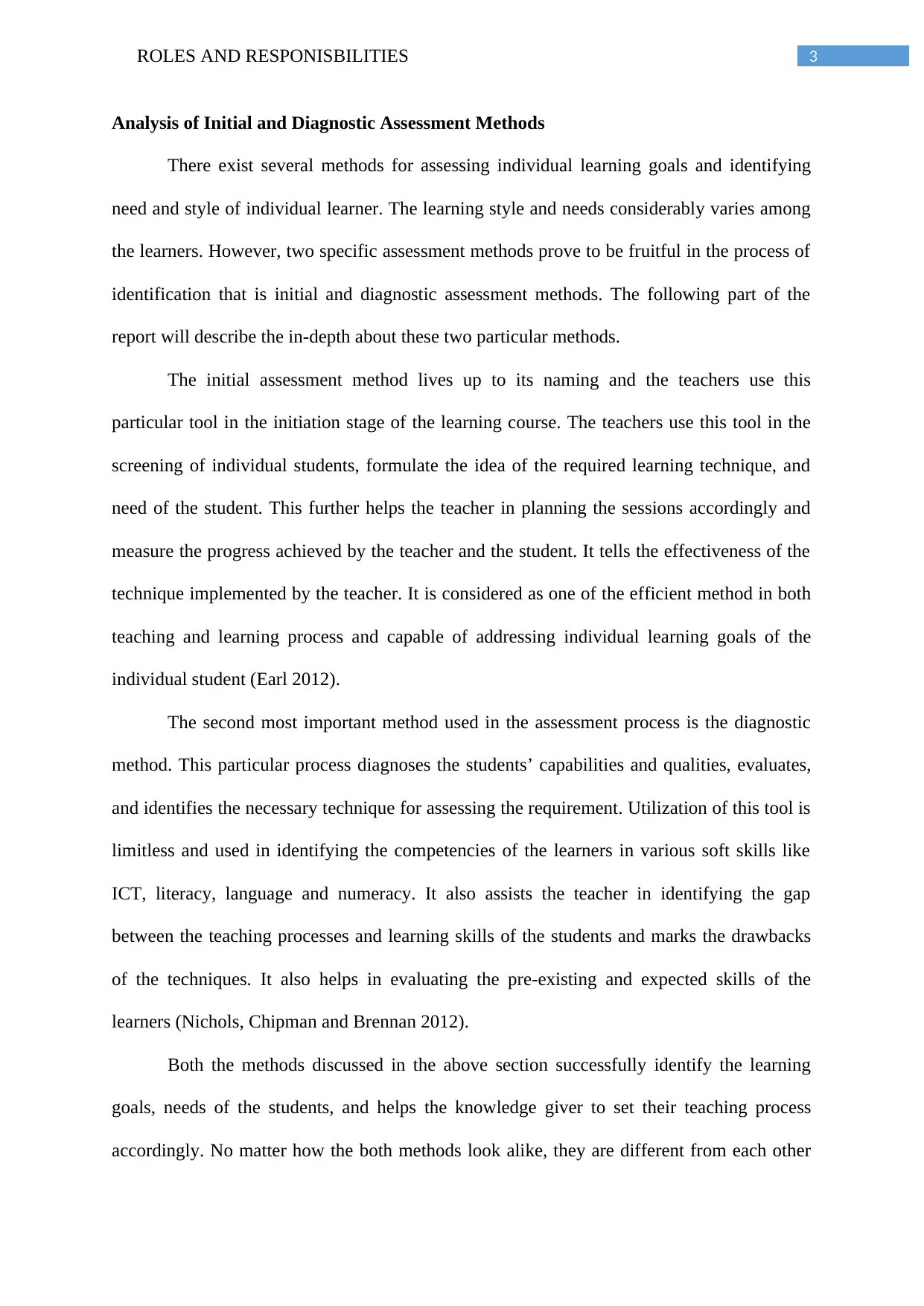
3ROLES AND RESPONISBILITIES
Analysis of Initial and Diagnostic Assessment Methods
There exist several methods for assessing individual learning goals and identifying
need and style of individual learner. The learning style and needs considerably varies among
the learners. However, two specific assessment methods prove to be fruitful in the process of
identification that is initial and diagnostic assessment methods. The following part of the
report will describe the in-depth about these two particular methods.
The initial assessment method lives up to its naming and the teachers use this
particular tool in the initiation stage of the learning course. The teachers use this tool in the
screening of individual students, formulate the idea of the required learning technique, and
need of the student. This further helps the teacher in planning the sessions accordingly and
measure the progress achieved by the teacher and the student. It tells the effectiveness of the
technique implemented by the teacher. It is considered as one of the efficient method in both
teaching and learning process and capable of addressing individual learning goals of the
individual student (Earl 2012).
The second most important method used in the assessment process is the diagnostic
method. This particular process diagnoses the students’ capabilities and qualities, evaluates,
and identifies the necessary technique for assessing the requirement. Utilization of this tool is
limitless and used in identifying the competencies of the learners in various soft skills like
ICT, literacy, language and numeracy. It also assists the teacher in identifying the gap
between the teaching processes and learning skills of the students and marks the drawbacks
of the techniques. It also helps in evaluating the pre-existing and expected skills of the
learners (Nichols, Chipman and Brennan 2012).
Both the methods discussed in the above section successfully identify the learning
goals, needs of the students, and helps the knowledge giver to set their teaching process
accordingly. No matter how the both methods look alike, they are different from each other
Analysis of Initial and Diagnostic Assessment Methods
There exist several methods for assessing individual learning goals and identifying
need and style of individual learner. The learning style and needs considerably varies among
the learners. However, two specific assessment methods prove to be fruitful in the process of
identification that is initial and diagnostic assessment methods. The following part of the
report will describe the in-depth about these two particular methods.
The initial assessment method lives up to its naming and the teachers use this
particular tool in the initiation stage of the learning course. The teachers use this tool in the
screening of individual students, formulate the idea of the required learning technique, and
need of the student. This further helps the teacher in planning the sessions accordingly and
measure the progress achieved by the teacher and the student. It tells the effectiveness of the
technique implemented by the teacher. It is considered as one of the efficient method in both
teaching and learning process and capable of addressing individual learning goals of the
individual student (Earl 2012).
The second most important method used in the assessment process is the diagnostic
method. This particular process diagnoses the students’ capabilities and qualities, evaluates,
and identifies the necessary technique for assessing the requirement. Utilization of this tool is
limitless and used in identifying the competencies of the learners in various soft skills like
ICT, literacy, language and numeracy. It also assists the teacher in identifying the gap
between the teaching processes and learning skills of the students and marks the drawbacks
of the techniques. It also helps in evaluating the pre-existing and expected skills of the
learners (Nichols, Chipman and Brennan 2012).
Both the methods discussed in the above section successfully identify the learning
goals, needs of the students, and helps the knowledge giver to set their teaching process
accordingly. No matter how the both methods look alike, they are different from each other
Paraphrase This Document
Need a fresh take? Get an instant paraphrase of this document with our AI Paraphraser
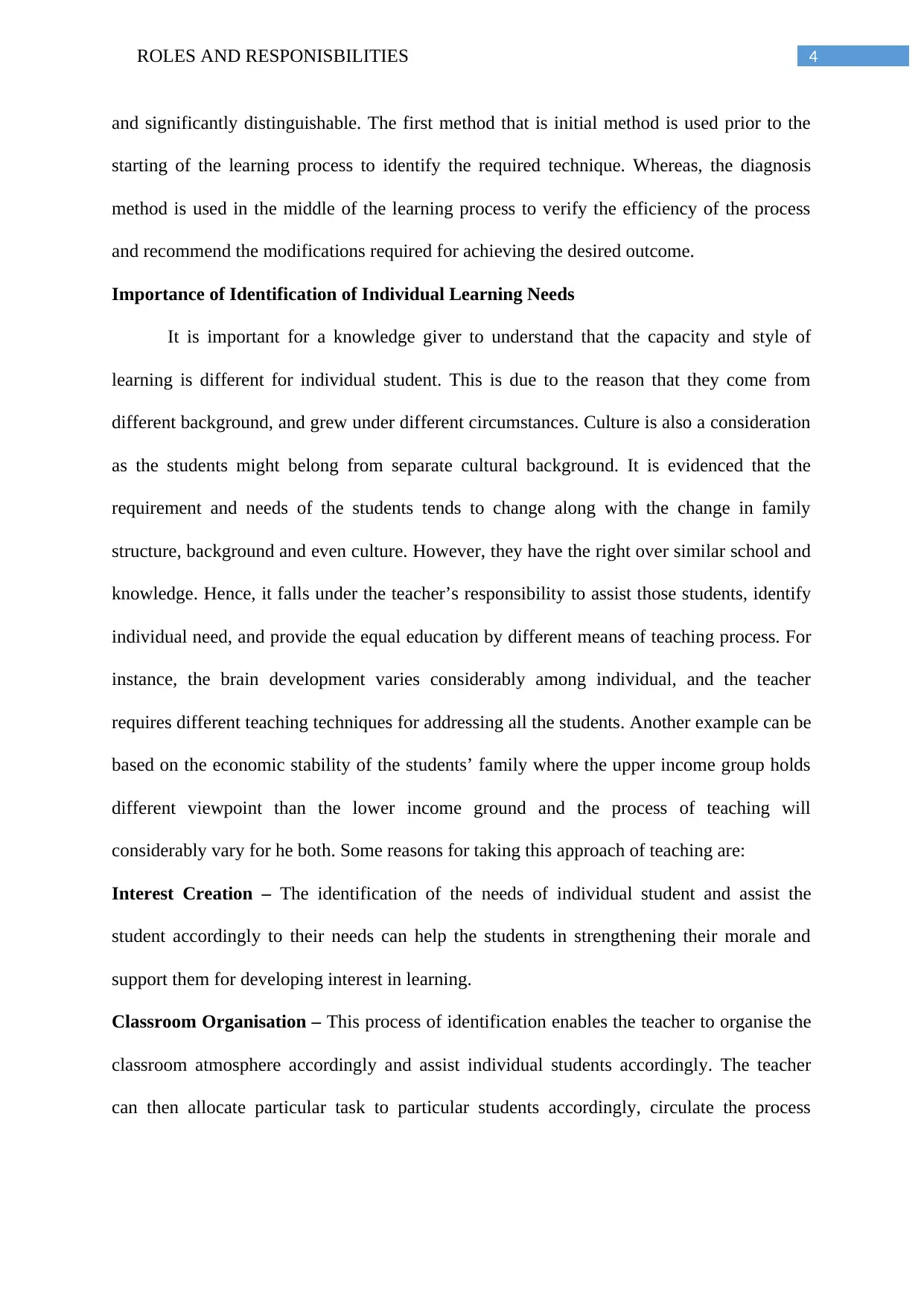
4ROLES AND RESPONISBILITIES
and significantly distinguishable. The first method that is initial method is used prior to the
starting of the learning process to identify the required technique. Whereas, the diagnosis
method is used in the middle of the learning process to verify the efficiency of the process
and recommend the modifications required for achieving the desired outcome.
Importance of Identification of Individual Learning Needs
It is important for a knowledge giver to understand that the capacity and style of
learning is different for individual student. This is due to the reason that they come from
different background, and grew under different circumstances. Culture is also a consideration
as the students might belong from separate cultural background. It is evidenced that the
requirement and needs of the students tends to change along with the change in family
structure, background and even culture. However, they have the right over similar school and
knowledge. Hence, it falls under the teacher’s responsibility to assist those students, identify
individual need, and provide the equal education by different means of teaching process. For
instance, the brain development varies considerably among individual, and the teacher
requires different teaching techniques for addressing all the students. Another example can be
based on the economic stability of the students’ family where the upper income group holds
different viewpoint than the lower income ground and the process of teaching will
considerably vary for he both. Some reasons for taking this approach of teaching are:
Interest Creation – The identification of the needs of individual student and assist the
student accordingly to their needs can help the students in strengthening their morale and
support them for developing interest in learning.
Classroom Organisation – This process of identification enables the teacher to organise the
classroom atmosphere accordingly and assist individual students accordingly. The teacher
can then allocate particular task to particular students accordingly, circulate the process
and significantly distinguishable. The first method that is initial method is used prior to the
starting of the learning process to identify the required technique. Whereas, the diagnosis
method is used in the middle of the learning process to verify the efficiency of the process
and recommend the modifications required for achieving the desired outcome.
Importance of Identification of Individual Learning Needs
It is important for a knowledge giver to understand that the capacity and style of
learning is different for individual student. This is due to the reason that they come from
different background, and grew under different circumstances. Culture is also a consideration
as the students might belong from separate cultural background. It is evidenced that the
requirement and needs of the students tends to change along with the change in family
structure, background and even culture. However, they have the right over similar school and
knowledge. Hence, it falls under the teacher’s responsibility to assist those students, identify
individual need, and provide the equal education by different means of teaching process. For
instance, the brain development varies considerably among individual, and the teacher
requires different teaching techniques for addressing all the students. Another example can be
based on the economic stability of the students’ family where the upper income group holds
different viewpoint than the lower income ground and the process of teaching will
considerably vary for he both. Some reasons for taking this approach of teaching are:
Interest Creation – The identification of the needs of individual student and assist the
student accordingly to their needs can help the students in strengthening their morale and
support them for developing interest in learning.
Classroom Organisation – This process of identification enables the teacher to organise the
classroom atmosphere accordingly and assist individual students accordingly. The teacher
can then allocate particular task to particular students accordingly, circulate the process
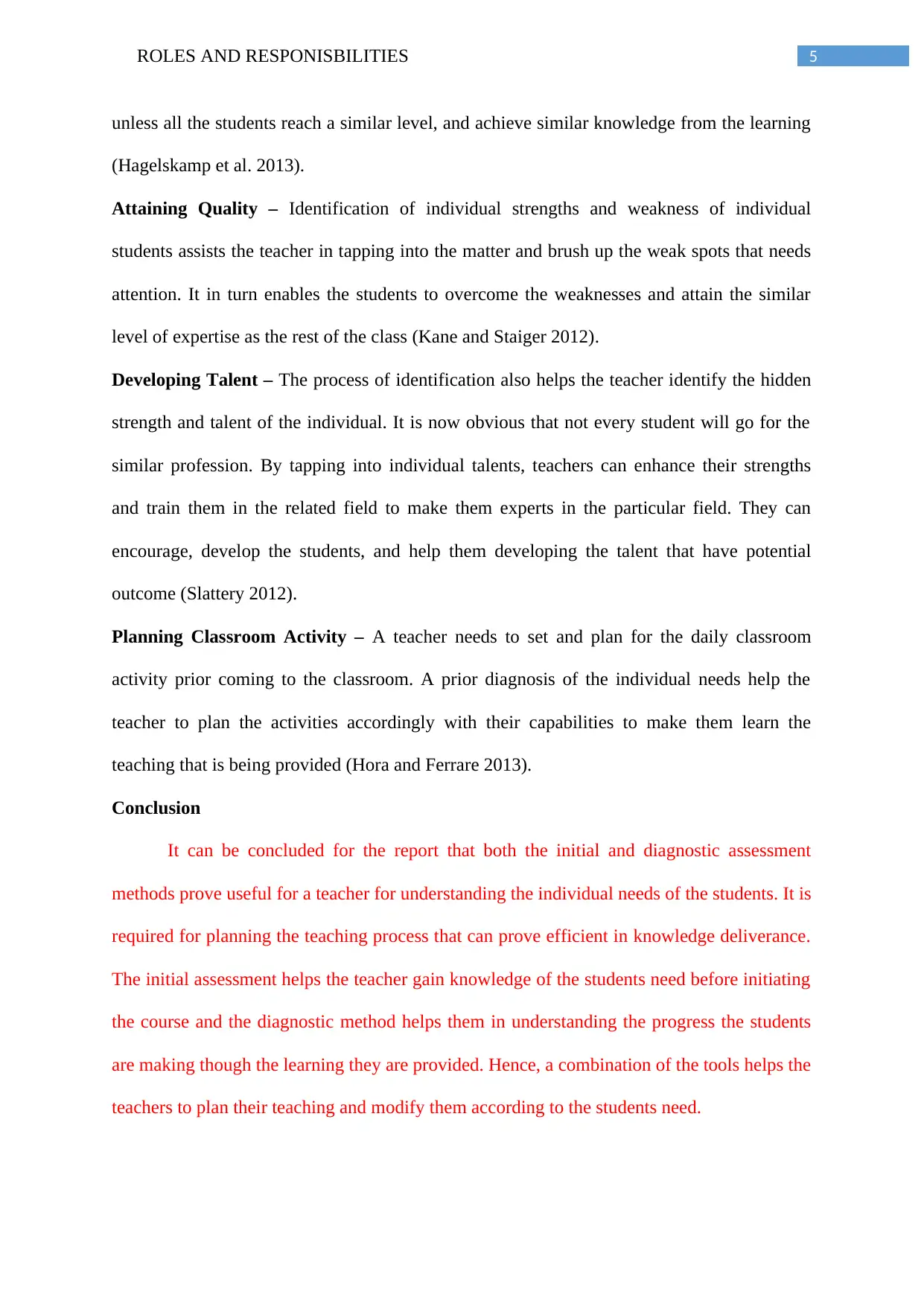
5ROLES AND RESPONISBILITIES
unless all the students reach a similar level, and achieve similar knowledge from the learning
(Hagelskamp et al. 2013).
Attaining Quality – Identification of individual strengths and weakness of individual
students assists the teacher in tapping into the matter and brush up the weak spots that needs
attention. It in turn enables the students to overcome the weaknesses and attain the similar
level of expertise as the rest of the class (Kane and Staiger 2012).
Developing Talent – The process of identification also helps the teacher identify the hidden
strength and talent of the individual. It is now obvious that not every student will go for the
similar profession. By tapping into individual talents, teachers can enhance their strengths
and train them in the related field to make them experts in the particular field. They can
encourage, develop the students, and help them developing the talent that have potential
outcome (Slattery 2012).
Planning Classroom Activity – A teacher needs to set and plan for the daily classroom
activity prior coming to the classroom. A prior diagnosis of the individual needs help the
teacher to plan the activities accordingly with their capabilities to make them learn the
teaching that is being provided (Hora and Ferrare 2013).
Conclusion
It can be concluded for the report that both the initial and diagnostic assessment
methods prove useful for a teacher for understanding the individual needs of the students. It is
required for planning the teaching process that can prove efficient in knowledge deliverance.
The initial assessment helps the teacher gain knowledge of the students need before initiating
the course and the diagnostic method helps them in understanding the progress the students
are making though the learning they are provided. Hence, a combination of the tools helps the
teachers to plan their teaching and modify them according to the students need.
unless all the students reach a similar level, and achieve similar knowledge from the learning
(Hagelskamp et al. 2013).
Attaining Quality – Identification of individual strengths and weakness of individual
students assists the teacher in tapping into the matter and brush up the weak spots that needs
attention. It in turn enables the students to overcome the weaknesses and attain the similar
level of expertise as the rest of the class (Kane and Staiger 2012).
Developing Talent – The process of identification also helps the teacher identify the hidden
strength and talent of the individual. It is now obvious that not every student will go for the
similar profession. By tapping into individual talents, teachers can enhance their strengths
and train them in the related field to make them experts in the particular field. They can
encourage, develop the students, and help them developing the talent that have potential
outcome (Slattery 2012).
Planning Classroom Activity – A teacher needs to set and plan for the daily classroom
activity prior coming to the classroom. A prior diagnosis of the individual needs help the
teacher to plan the activities accordingly with their capabilities to make them learn the
teaching that is being provided (Hora and Ferrare 2013).
Conclusion
It can be concluded for the report that both the initial and diagnostic assessment
methods prove useful for a teacher for understanding the individual needs of the students. It is
required for planning the teaching process that can prove efficient in knowledge deliverance.
The initial assessment helps the teacher gain knowledge of the students need before initiating
the course and the diagnostic method helps them in understanding the progress the students
are making though the learning they are provided. Hence, a combination of the tools helps the
teachers to plan their teaching and modify them according to the students need.
⊘ This is a preview!⊘
Do you want full access?
Subscribe today to unlock all pages.

Trusted by 1+ million students worldwide
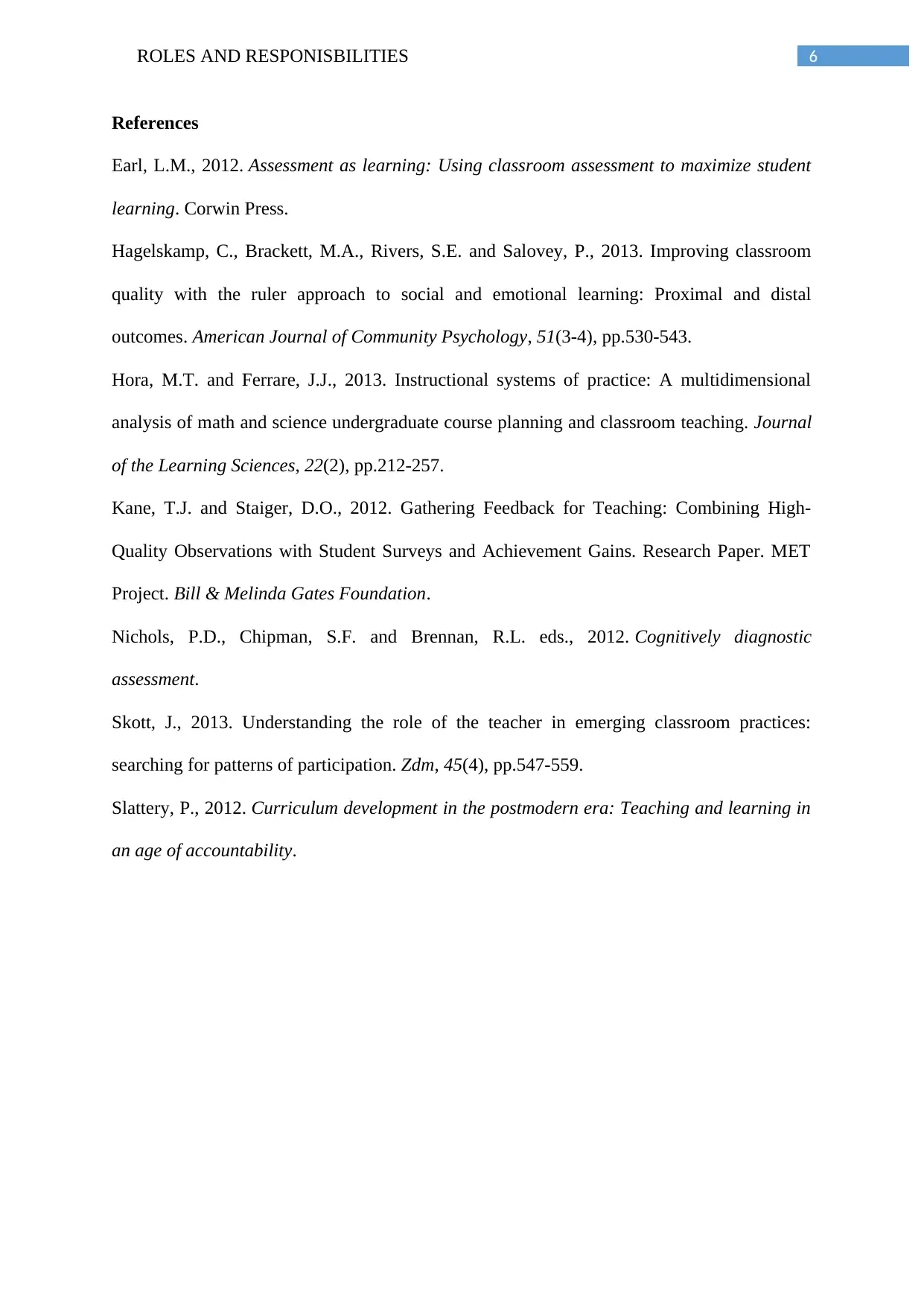
6ROLES AND RESPONISBILITIES
References
Earl, L.M., 2012. Assessment as learning: Using classroom assessment to maximize student
learning. Corwin Press.
Hagelskamp, C., Brackett, M.A., Rivers, S.E. and Salovey, P., 2013. Improving classroom
quality with the ruler approach to social and emotional learning: Proximal and distal
outcomes. American Journal of Community Psychology, 51(3-4), pp.530-543.
Hora, M.T. and Ferrare, J.J., 2013. Instructional systems of practice: A multidimensional
analysis of math and science undergraduate course planning and classroom teaching. Journal
of the Learning Sciences, 22(2), pp.212-257.
Kane, T.J. and Staiger, D.O., 2012. Gathering Feedback for Teaching: Combining High-
Quality Observations with Student Surveys and Achievement Gains. Research Paper. MET
Project. Bill & Melinda Gates Foundation.
Nichols, P.D., Chipman, S.F. and Brennan, R.L. eds., 2012. Cognitively diagnostic
assessment.
Skott, J., 2013. Understanding the role of the teacher in emerging classroom practices:
searching for patterns of participation. Zdm, 45(4), pp.547-559.
Slattery, P., 2012. Curriculum development in the postmodern era: Teaching and learning in
an age of accountability.
References
Earl, L.M., 2012. Assessment as learning: Using classroom assessment to maximize student
learning. Corwin Press.
Hagelskamp, C., Brackett, M.A., Rivers, S.E. and Salovey, P., 2013. Improving classroom
quality with the ruler approach to social and emotional learning: Proximal and distal
outcomes. American Journal of Community Psychology, 51(3-4), pp.530-543.
Hora, M.T. and Ferrare, J.J., 2013. Instructional systems of practice: A multidimensional
analysis of math and science undergraduate course planning and classroom teaching. Journal
of the Learning Sciences, 22(2), pp.212-257.
Kane, T.J. and Staiger, D.O., 2012. Gathering Feedback for Teaching: Combining High-
Quality Observations with Student Surveys and Achievement Gains. Research Paper. MET
Project. Bill & Melinda Gates Foundation.
Nichols, P.D., Chipman, S.F. and Brennan, R.L. eds., 2012. Cognitively diagnostic
assessment.
Skott, J., 2013. Understanding the role of the teacher in emerging classroom practices:
searching for patterns of participation. Zdm, 45(4), pp.547-559.
Slattery, P., 2012. Curriculum development in the postmodern era: Teaching and learning in
an age of accountability.
1 out of 7
Related Documents
Your All-in-One AI-Powered Toolkit for Academic Success.
+13062052269
info@desklib.com
Available 24*7 on WhatsApp / Email
![[object Object]](/_next/static/media/star-bottom.7253800d.svg)
Unlock your academic potential
Copyright © 2020–2025 A2Z Services. All Rights Reserved. Developed and managed by ZUCOL.



